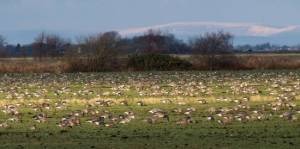Dr Phil Smith’s Wildlife Notes
January 2009
Despite the cold weather, my first sighting of that harbinger of spring, the Snowdrop (Galanthus nivalis), was at Moor Lane, Ainsdale as early as the 18th. A heavy frost partly froze Sands Lake, Ainsdale causing an influx of duck, including 175 Tufted Ducks and 55 Shovelers, the latter being the largest number I have seen here. Nearby, Ainsdale beach held a small flock of five to ten Snow Buntings throughout the month, while between 30 and 50 Twite remained on the shore at Weld Road, Birkdale, attracting many bird-watchers. Another winter-visitor, the Brambling, was reported on Rachael Parks’ garden bird-feeder; I caught up with half-a-dozen of these colourful northern finches in a large flock of about 400 Chaffinches on stubble at Churchtown Moss on 29th. Big finch flocks, like this one, used to be commonplace many years ago but the practice of ploughing cereal fields early and planting wheat in autumn instead of spring usually buries their winter feed. As a result, many formerly common farmland birds have sadly declined.

Another bird sometimes seen at garden feeders is the Blackcap, a warbler more usually thought of as a summer visitor to woodland. Catherine Highfield told me of a female (with a brown cap) in her Formby garden. Blackcaps only started wintering locally in 1959, numbers having steadily increased until the north Merseyside & Lancashire population is now estimated at 100+. Interestingly, our breeding Blackcaps still migrate to southern Europe and Africa, while those wintering here originate in central and western Europe, especially Germany.
Martin Mere’s Whooper Swans peaked at 1600 during January; several are now wearing small transmitters so that their migrations to and from Iceland can be studied. The related but smaller Bewick’s Swan makes a much longer flight from Siberia. Numbers have declined in our area over recent decades as warmer winters have allowed them to remain in Germany and Holland. Nevertheless, a few still make the extra miles to grace our wetlands, 19 being reported at Martin Mere and a flock of up to 49 at Hundred End on the Ribble. One of the Martin Mere birds was ringed in 1991 when four to five years old, so is now around 23. It has travelled at least 100,000 miles during its long life!
The Marshside reserve had its usual Green-winged Teal, a Spotted Redshank and several Little Egrets, as many as 26 of which roosted at night on one of the Southport Marine Lake islands.
Mere Sands Wood Nature Reserve is another popular venue for bird-watchers in winter, January attractions here including a small flock of Crossbills, several Goosanders and, briefly, a Bittern. This is also a good place to see the handsome Bullfinch, now much scarcer in our region than it used to be.
One bird that has surprised everyone by its dramatic recent increase, especially since about 2000, is the Buzzard. It is now a widespread breeder locally and, since most of the population seems to be sedentary, lots can also be seen in winter. Thus, on 24th January, a calm, sunny day, I counted eight soaring over Altcar Withins and another four on Altcar Moss. The harvested potato fields and stubble on the mosslands also attracted large flocks of Pink-footed Geese, their noisy skeins flying over my home each evening to roost on the shore. At the end of the month I was lucky enough to find one Russian Whitefront, four Greenland Whitefronts, a Bean Goose and a Canada Goose with about 7000 Pinkfeet just inland of Formby.

